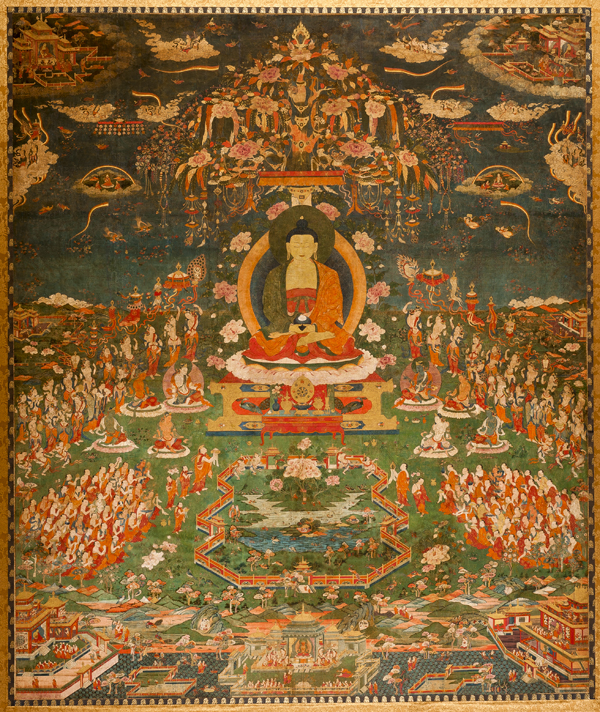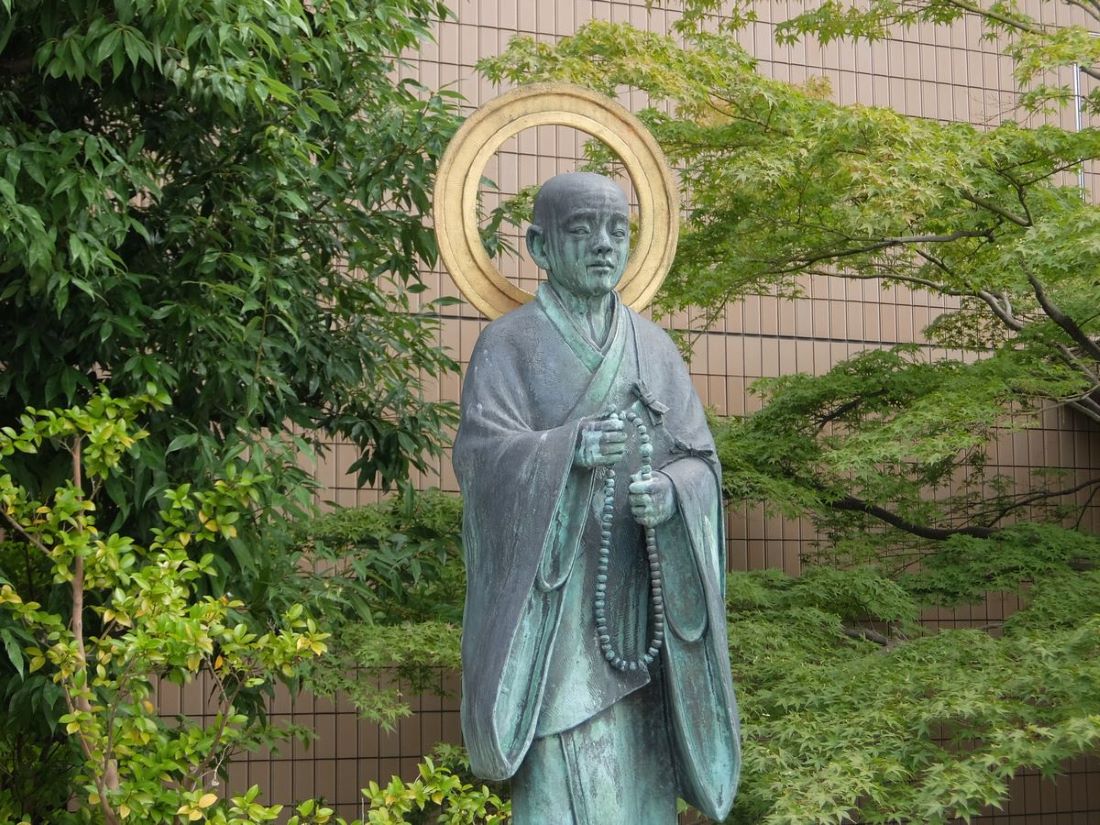Pure Land Buddhism is a form of Mahayana Buddhism that originated in China and later spread to Japan. It is one of the most widely practiced forms of Buddhism in Japan and has a significant influence on Japanese culture and society. The main focus of Pure Land Buddhism is the belief in Amitabha Buddha and his Pure Land, which is a heavenly realm of enlightenment and liberation from suffering.
The practice of Pure Land Buddhism involves reciting the name of Amitabha Buddha, known as the nembutsu, with the goal of being reborn in his Pure Land after death. This practice is accessible to all people, regardless of their social status or level of education, and is considered a simple and effective way to attain enlightenment. Pure Land Buddhism has also been influential in the development of Japanese art, literature, and culture, with many famous artists and writers being followers of this tradition.
History of Pure Land Buddhism in Japan

Pure Land Buddhism, also known as Amidism, is a sect of Mahayana Buddhism that originated in China during the 4th century. The sect was introduced to Japan in the 8th century, during the Nara period, by the monk Gembō. It gained popularity among the common people and became one of the most influential Buddhist sects in Japan.
During the Kamakura period in the 12th century, Pure Land Buddhism experienced a resurgence in popularity. The monk Hōnen played a significant role in spreading the teachings of the sect, emphasizing the importance of reciting the name of the Buddha Amitabha. This practice, known as nembutsu, became the cornerstone of Pure Land Buddhism in Japan.

The popularity of Pure Land Buddhism continued to grow during the Muromachi period in the 14th century. The monk Rennyo, a disciple of Hōnen, led a revival of the sect and established the Jōdo Shinshū school of Pure Land Buddhism. This school emphasized the concept of faith, stating that it was the most important aspect of attaining enlightenment.
During the Edo period in the 17th century, Pure Land Buddhism became the dominant form of Buddhism in Japan. The Tokugawa shogunate supported the sect and provided funding for the construction of temples and other religious institutions. This support led to the creation of many famous Pure Land Buddhist temples, such as the Jōdo-ji temple in Onomichi and the Chion-in temple in Kyoto.
Today, Pure Land Buddhism remains one of the most popular Buddhist sects in Japan. Its teachings continue to resonate with the Japanese people, who value the concept of rebirth in the Pure Land and the attainment of enlightenment through faith in the Buddha Amitabha.
Teachings and Beliefs of Pure Land Buddhism

Pure Land Buddhism is a sect of Mahayana Buddhism that is centered on the belief in the Western Paradise, also known as the Pure Land. The sect is based on the teachings of the Chinese monk Huiyuan, who taught that one could achieve enlightenment by chanting the name of Amitabha Buddha.
The core belief is that through devotion to Amitabha Buddha, one can be reborn in the Pure Land, where it is easier to attain enlightenment. The Pure Land is described as a place of bliss and happiness, free from suffering and the distractions of the world.
it teaches that all beings have Buddha-nature, the potential to become enlightened. It also emphasizes the importance of compassion and the practice of the six paramitas, or perfections: generosity, morality, patience, effort, concentration, and wisdom.
One of the key practices of Pure Land Buddhism is the recitation of the nembutsu, which is the repetition of the name of Amitabha Buddha. This practice is believed to help purify the mind and create the conditions for rebirth in the Pure Land.
In addition to the nembutsu, Pure Land Buddhism also emphasizes the importance of faith, devotion, and gratitude. Practitioners are encouraged to cultivate a deep sense of gratitude towards Amitabha Buddha and to express this gratitude through acts of kindness and service to others.
Overall, Pure Land Buddhism is a sect that emphasizes the importance of devotion, compassion, and the practice of the six paramitas. Through these practices, practitioners seek to attain rebirth in the Pure Land and ultimately achieve enlightenment.
Pure Land Buddhist Practices and Rituals in Japan

One of the most important practices in Pure Land Buddhism is chanting the name of Amida Buddha, who is believed to have created the Pure Land. This practice is known as nembutsu, and it involves repeating the phrase “Namu Amida Butsu” (meaning “I take refuge in Amida Buddha”) over and over again.
This practice is believed to help practitioners focus their minds and cultivate a sense of gratitude towards Amida Buddha. Another important practice in Pure Land Buddhism is the recitation of sutras, particularly the Larger Sutra of Immeasurable Life and the Smaller Sutra of Immeasurable Life.
These sutras describe the story of Amida Buddha and the Pure Land, and they are believed to have the power to purify the mind and bring practitioners closer to Amida Buddha. In addition to these practices, Pure Land Buddhism also has a number of rituals that are performed in temples and other sacred spaces.
Impact of Pure Land Buddhism on Japanese Culture

Pure Land Buddhism has had a significant impact on Japanese culture since its introduction in the 12th century. It has influenced various aspects of Japanese society, including art, literature, and philosophy. Here are a few examples of how Pure Land Buddhism has shaped Japanese culture:
- Art: Pure Land Buddhism has inspired some of Japan’s most famous artworks, such as the Amida Buddha statues found in temples throughout the country. The belief in Amida Buddha’s power to save all sentient beings has also influenced the creation of mandalas and other religious art.
- Literature: Many Japanese writers have been influenced by Pure Land Buddhism, including the famous poet Saigyo, who wrote about the beauty of nature and the transience of life. Pure Land Buddhism has also inspired the creation of popular folktales and legends, such as the story of the fisherman and the turtle.
- Philosophy: Pure Land Buddhism has had a profound impact on Japanese philosophy, particularly in the areas of ethics and morality. The belief in Amida Buddha’s vow to save all beings has led to a strong emphasis on compassion and the importance of helping others in Japanese society.
Overall, Pure Land Buddhism has played a significant role in shaping Japanese culture over the past eight centuries. Its influence can be seen in everything from the country’s art and literature to its philosophy and values.
Contemporary Pure Land Buddhist Movements in Japan
Pure Land Buddhism has been an important part of Japanese culture for centuries. In recent years, there have been several contemporary Pure Land Buddhist movements that have emerged in Japan. These movements have gained popularity among younger generations and have adapted to modern society.
One of the most prominent contemporary Pure Land Buddhist movements in Japan is the Jodo Shinshu Hongwanji-ha. This movement was founded by Shinran, a 13th-century monk who believed that enlightenment could be achieved through devotion to Amitabha Buddha.
Today, the Jodo Shinshu Hongwanji-ha has over 10 million followers in Japan and around the world. They have modernized their practices to include online services and social media outreach. Another contemporary Pure Land Buddhist movement is the Rissho Kosei-kai.
This movement was founded in 1938 by Nikkyo Niwano and Myoko Naganuma. They believe in the importance of self-reflection and self-improvement, as well as the power of chanting to achieve inner peace.
The Rissho Kosei-kai has over 1.5 million members in Japan and has expanded to over 70 countries worldwide. The Shinnyo-en movement is another contemporary Pure Land Buddhist movement that has gained popularity in Japan. Founded in 1936 by Shinjo Ito, Shinnyo-en emphasizes the importance of meditation and self-reflection.
They also believe in the power of compassion and have organized several humanitarian efforts around the world. Overall, these contemporary Pure Land Buddhist movements in Japan have adapted to modern society while still maintaining the core beliefs and practices of Pure Land Buddhism.
They have gained popularity among younger generations and have expanded their outreach through social media and humanitarian efforts.
The Sum Up

Pure Land Buddhism has a significant place in the religious landscape of Japan. It has provided a path for millions of Japanese people to connect with the divine and find a way to navigate the complexities of life. The teachings of Pure Land Buddhism, with its emphasis on the power of Amida Buddha, have helped individuals find peace and solace in times of difficulty.
Throughout history, Pure Land Buddhism has undergone many changes and adaptations. From the early days of Honen and Shinran to the present day, the teachings have evolved to meet the needs of the people. In Japan, Pure Land Buddhism has become an integral part of the country’s religious and cultural identity.
While Pure Land Buddhism has faced challenges in recent years, it remains a vital force in Japanese society. Its teachings continue to inspire and guide people from all walks of life. Whether it is through the recitation of the nembutsu or the study of the sutras, Pure Land Buddhism provides a way for individuals to connect with the divine and find meaning in their lives.
Overall, Pure Land Buddhism has had a profound impact on Japanese culture and society. Its teachings have helped shape the country’s religious landscape and provided a way for individuals to connect with the divine. As we look to the future, it is clear that Pure Land Buddhism will continue to play an important role in the spiritual lives of many Japanese people.




